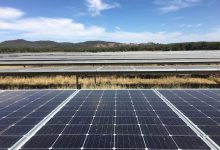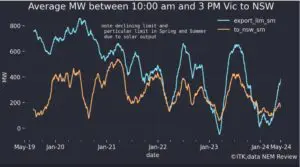The only pure solar play on the Australian stock market, New Energy Solar, says it remains optimistic for the future of large-scale solar projects despite the Covid-19 related disruptions leading to almost $60 million in write-downs in the value of its US and Australian project portfolio.
The company on Friday reported an overall loss $55.6 million after write downs, despite the fact that higher revenue from energy sales grew over the 2019-20 financial year helped it to a 47 per cent increase in underlying earnings as new projects came online.
The write-downs were felt across both its US and Australian based solar projects, mostly from its US portfolio of 14 solar projects, but it also included a $4.8 million reduction in the equity it holds in the Manildra solar farm in New South Wales.
New Energy Solar’s two Australian based projects, Manildra and Beryl solar farms, rank as some of the best performing solar projects in the National Electricity Market, and so have been shielded from larger impacts relating to grid connection difficulties that have been felt elsewhere.
See: Revealed: The solar farms that found the sweet spot in the grid, and those that didn’t
However, the company remains optimistic that it can confidently ride through the Covid-19 era in energy markets, thanks mostly to its long term contracts.
“The NEW portfolio is now fully-contracted, and we are managing operational and weather-related issues inherent in a real asset portfolio,”New Energy Solar CEO John Martin said.
“So far, the day-to-day physical operations of the solar plants have not been significantly impeded by the COVID-19 pandemic and it has been pleasing to see that globally, renewables have become increasingly significant contributors to electricity supplies.
“However, the virus and the government-mandated shutdowns and restrictions have adversely impacted global economies and long-term expectations of market conditions in the energy sector. This has seen a decline in long-term electricity price projections since the last period which has required NEW to recognise a reduction in its net asset value.”
New Energy Solar operates a 772MW portfolio of large-scale solar projects, located across Australia and the United States, including more than 150MW of solar capacity in New South Wales.
Ahead of the earnings call, the company had flagged that it would revise future assumptions for wholesale electricity prices following the global economic disruption caused by Covid-19. New Energy Solar revised down its future expectations for wholesale electricity prices, and as a result, flagged that it would revise down the ‘fair value’ valuation of its portfolio.
For the 2019-20 year, these write downs amounted to $59.6 million, wiping out the company’s underlying earnings, and seeing the company’s net asset value per share fall to around $1.32 per share. The difficulties have seen New Energy Solar’s shares fall by around 35 per cent over the last 12 months and are currently trading around 87 cents per share.
New Energy Solar operates as a type of ‘yieldco’ to generate dividends for shareholders through the ownership of established solar farms, with revenues secured through long-term power purchase agreements and announced that it would cut its next dividend to 3 cents, after delivering a 4 cent dividend in December last year.
The company notes that forecasts from the US Energy Information Administration for 2020 and 2021 suggest renewables are expected to surpass coal and nuclear in terms of contribution to the US power sector generation next year.

“Most notably in this period, the contribution of coal fired generation has declined very significantly. The International Energy Agency notes that global coal demand in the first quarter of this year fell by almost 8 per cent compared to the same quarter in 2019. Material part of this fall is attributable to the early impact of Covid-19 restrictions in China curtailing economic activity.”
Electricity demand has fallen across all regions of the world in 2020 so far, including a reversal of very strong electricity demand growth in China and India as manufacturing activities slowed.

New Energy Solar noted that for wind and solar projects, forecast falls in global electricity demand have an impact through reduced wholesale electricity prices, while energy sales from renewables projects would remain stable.
The company pointed to recently publishes statistics from the International Energy Agency which showed that coal generation has taken the brunt of falls in global electricity demand, while output from lower marginal cost wind and solar projects actually increased.
“While the full implications of this period will not be apparent for some time, the energy sector disruption and transition to low carbon generation sources appears to be ongoing, if not more quickly, in some quarters,” New Energy Solar CEO John Martin told investors.










